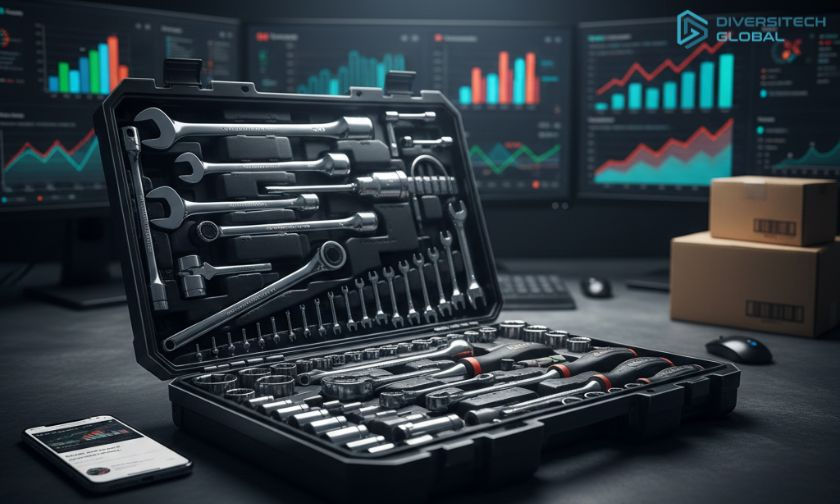Trends in Pliers and Cutters Materials 2024
- Diversitech Global

- May 3, 2024
- 4 min read
Updated: May 9, 2024

The manufacturing landscape for hand tools, particularly pliers and cutters, is witnessing a significant transformation as we approach the year 2024. Innovations in materials science and manufacturing technologies are driving this change, leading to the development of tools that are more durable, efficient, and suited to the evolving needs of professionals globally. Any top Pliers and Cutters manufacturer in China is at the forefront of these advancements, leveraging new materials and processes to enhance tool performance and user satisfaction. These developments are not merely technical achievements; they represent a shift towards sustainability, improved ergonomics, and enhanced functionality that redefines what professionals can expect from their hand tools.
The focus on material innovation underscores a broader trend in the DIY tool, hardware shop retail, and global manufacturing sectors towards higher quality and specificity in tool design. Manufacturers are responding to demands from users for tools that last longer, perform better, and offer features that traditional materials cannot provide. This article explores the latest trends in materials for pliers and cutters set to dominate the market in 2024, shedding light on how these innovations are shaping the future of hand tools.
Related Article: Pliers Tool Definition: What are Pliers?
Advanced Steel Alloys
The backbone of any high-quality plier or cutter is the steel alloy used in its construction. Steel alloys have long been favored for their strength, durability, and versatility. However, the year 2024 sees an evolution in the use of advanced steel alloys, which offer improved characteristics over traditional options.
High-Carbon Stainless Steels
Enhanced corrosion resistance combined with the inherent strength of high-carbon steel makes these alloys particularly suitable for pliers and cutters exposed to harsh conditions.
Cobalt and Vanadium Steel Alloys
The addition of cobalt and vanadium increases the wear resistance and overall toughness of the tools, enabling them to maintain sharp edges and structural integrity even under heavy use.
Cryogenic Treatment Processes
Advanced treatment processes involving cooling the steel to cryogenic temperatures significantly improve the dimensional stability and longevity of the tools, making them a superior choice for professional applications.
Composite Materials
Composite materials are becoming increasingly popular in the manufacturing of pliers and cutters, offering unique properties that traditional metals cannot match. These materials combine the strength and durability of metals with the lightweight and corrosion-resistant characteristics of polymers and ceramics.
Fiber-Reinforced Polymers (FRP)
FRPs are being used in the handles and bodies of pliers and cutters to reduce weight without compromising strength, enhancing the tool's ergonomics and user comfort.
Metal Matrix Composites (MMC)
MMCs incorporate metal with another material, such as ceramic, to create tools with exceptional hardness and temperature resistance, ideal for precision cutting and gripping applications.
Carbon Fiber Components
The use of carbon fiber in select tool components offers an unparalleled strength-to-weight ratio, significantly reducing tool fatigue without sacrificing performance.
Want to incorporate sustainability into your craft & art tool kits & double your sales? Get in touch
Eco-Friendly and Sustainable Materials
Sustainability is a major driving force behind material innovation in the pliers and cutters market. Manufacturers are exploring eco-friendly materials that minimize environmental impact without compromising tool quality or functionality.
Recycled Steel Alloys
Utilizing recycled steel not only conserves natural resources but also reduces the carbon footprint associated with tool manufacturing, appealing to environmentally conscious consumers.
Biodegradable Plastics for Handles
Incorporating biodegradable plastics in tool handles offers a pathway to reducing plastic waste, with materials designed to break down safely after the tool's lifespan ends.
Non-Toxic Coatings and Treatments
The shift towards non-toxic coatings for corrosion resistance and surface treatment ensures user safety and environmental protection, marking a departure from traditional, chemical-heavy processes.
Innovative Surface Treatments
Surface treatments and coatings play a critical role in extending the life of pliers and cutters, protecting against corrosion, wear, and environmental damage. The latest trends focus on innovative treatments that offer superior protection and additional functionalities.
Diamond-Like Carbon (DLC) Coatings
DLC coatings provide exceptional hardness and reduced friction, greatly enhancing the cutting performance and longevity of pliers and cutters.
Nano-Ceramic Coatings
Offering excellent corrosion resistance and thermal stability, nano-ceramic coatings are ideal for tools used in high-moisture or high-temperature environments.
Self-Healing Coatings
Emerging self-healing coatings can repair minor scratches and abrasions, maintaining the tool's protective layer and extending its usable life significantly.
Ergonomic Material Enhancements
Ergonomics is a key consideration in tool design, with materials playing a pivotal role in improving user comfort and reducing strain during prolonged use. Innovations in ergonomic materials are focused on enhancing grip, reducing weight, and increasing control.
Thermoplastic Elastomers (TPE) for Grips
TPEs provide a soft yet durable surface for tool handles, offering improved grip and comfort, especially in extreme temperatures or wet conditions.
Vibration-Damping Materials
Materials designed to dampen vibrations can significantly reduce user fatigue and the risk of vibration-induced injury, making tools safer and more comfortable to use for extended periods.
Lightweight Alloys and Composites
The development of lighter-weight materials that do not compromise on strength or durability allows for the production of tools that are easier to handle and manipulate, reducing user fatigue.
The Future of Tool Manufacturing
The advancements in materials science and manufacturing technology herald a new era for pliers and cutters. These developments are not just about creating better tools; they are about redefining what tools can be. The emphasis on sustainability, ergonomics, and performance reflects a broader shift in the industry towards innovation and user-centered design.
Customization and Personalization
Future trends may include the ability to customize tools according to specific user preferences or requirements, offering personalized ergonomics and functionalities.
Smart Tools with Integrated Technologies
The integration of smart technologies within tools, such as RFID tags for inventory management or sensors for usage tracking, presents exciting possibilities for the future of the industry.
Collaboration with End Users
Ongoing collaboration between manufacturers and end users ensures that the tools being developed meet the real-world needs of professionals, driving continuous improvement and innovation.
Related Article: Ergonomics Designs of Pliers and Cutters
Leading the Way Forward
The trends in pliers and cutters materials for 2024 represent a convergence of technology, sustainability, and user-centric design. Manufacturers are not just responding to the current demands of the market; they are anticipating the future needs of professionals around the world. These innovations in materials and manufacturing processes are setting new standards for quality, performance, and sustainability in the hand tool industry, ensuring that professionals have access to tools that are not only effective but also safe and environmentally responsible.
Want to incorporate sustainability into your craft & art tool kits & double your sales? Get in touch




Comments